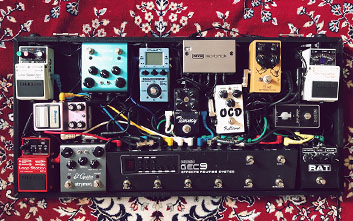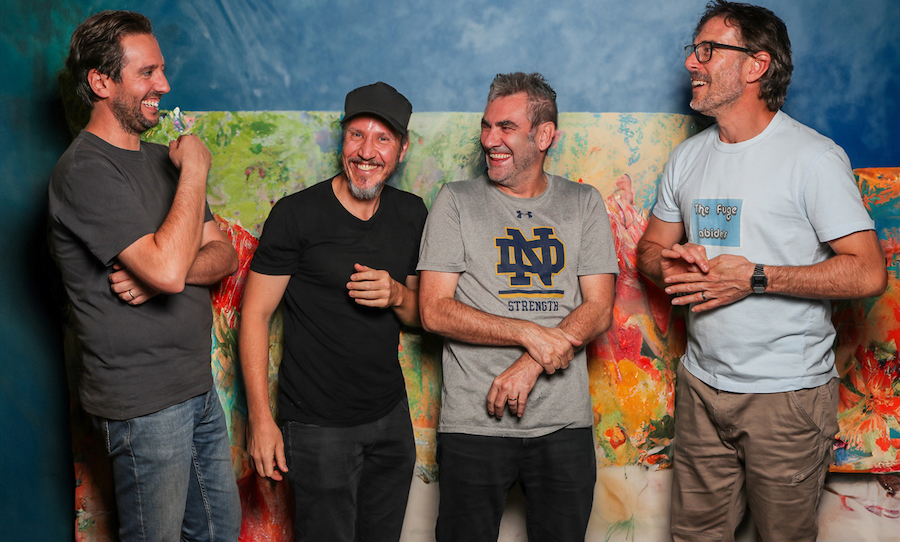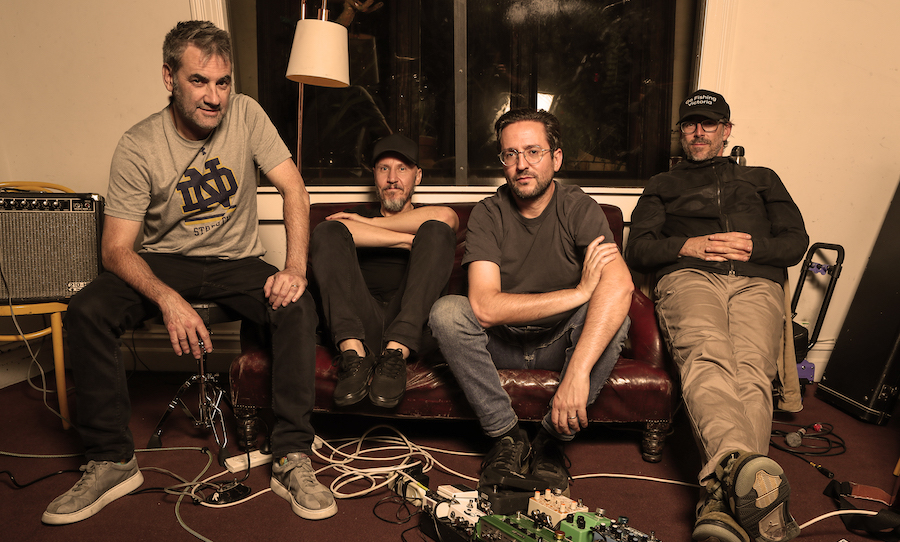Adelaide shoegaze outfit Blush Response have just released their newest single Cruel, a dreamy slow burner brimming with just the right amount of fuzz. We had the pleasure of premiering the track last week, and it’s been on repeat ever since.
Since it’s always a safe bet on shoegaze bands, we were sure Blush Response were packing some serious gear behind that mountainous sound. After reaching out to guitarist Alister, our suspicions were confirmed.
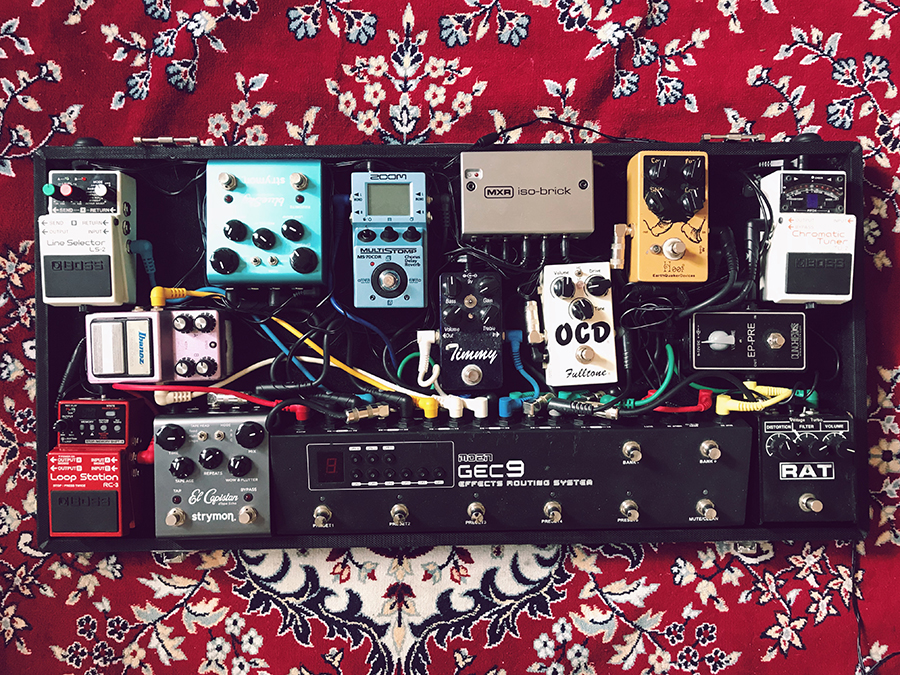
Twin amps, washy distortion and harnessing feedback: find out the guitar, amps and pedals behind Blush Response’s cacophonous wall of sound.
HAPPY: Can you run us through what’s on your board at the moment?
ALISTER: My board currently has a Moen GEC9, Boss TU-2, Clinch FX EP-Pre, ProCo Rat 2, Fulltone OCD, Paul Cochrane Timmy, Ibanez BC9, Strymon El Capistan, Strymon Blue Sky, Boss RC3, Earthquaker Devices Hoof, Zoom MS70CDR and a Boss LS-2. It may sound a little excessive at first but there’s two amps worth of pedals on there.
HAPPY: How about your guitar? Also, two amps?
ALISTER: My guitar is a 62 AVRI Jazzmaster with a Mexican Stratocaster neck. There was nothing special about the choice of neck other than I couldn’t afford a whole AVRI Jazzmater at the time so decided to buy a cheaper neck as a stopgap. The neck has since grown on me and I haven’t felt the need to replace it. The guitar used to be Candy Apple Red, but I stripped it and had it painted a light blue. Lately I’ve been wishing that I wrote down the colour code of the paint so I could make a matching headstock down the track, but I didn’t think that far ahead.
For my amps, I use a Vox AC30 and AC15. Each amp has its own effects chain. I’d love to run two AC30s but they’re so heavy and cumbersome that I don’t think I could bear to lug two of them around to gigs.
HAPPY: I really dig the way you use feedback in the intro to Cruel. What are we hearing there?
ALISTER: I really like layering feedback into recordings because there’s no way to achieve decent sounding feedback at anything other than obnoxious volumes. Because of this I feel it really adds an impression of volume to recordings. Nothing special about the way it was created; just my Jazzmaster into the AC30 via a gained up Rat. Hold the guitar up to the amp and go.
HAPPY: What was the first pedal you bought? Do you still use it?
ALISTER: My first pedal was a secondhand Zoom 506 Bass multi-fx pedal that I used on guitar. This was before I played in bands or knew anything about pedals. It had the most tacky sounds you can imagine and the button that let you save patches was broken so you had to create a new patch every time if you wanted something different. It’s long gone, thank god. The first pedal I bought to use in a band was an Ibanez TS9 – it’s also long gone.
HAPPY: What’s your favourite pedal under 100 bucks and why?
ALISTER: Ninevolt’s Fishing Is As Fun As Fuzz. It’s a cheap and cheerful Muff style circuit with a cute name/artwork. I got mine for new for $90 when I was in Tokyo, though I think they might be just over $100 in Australia.
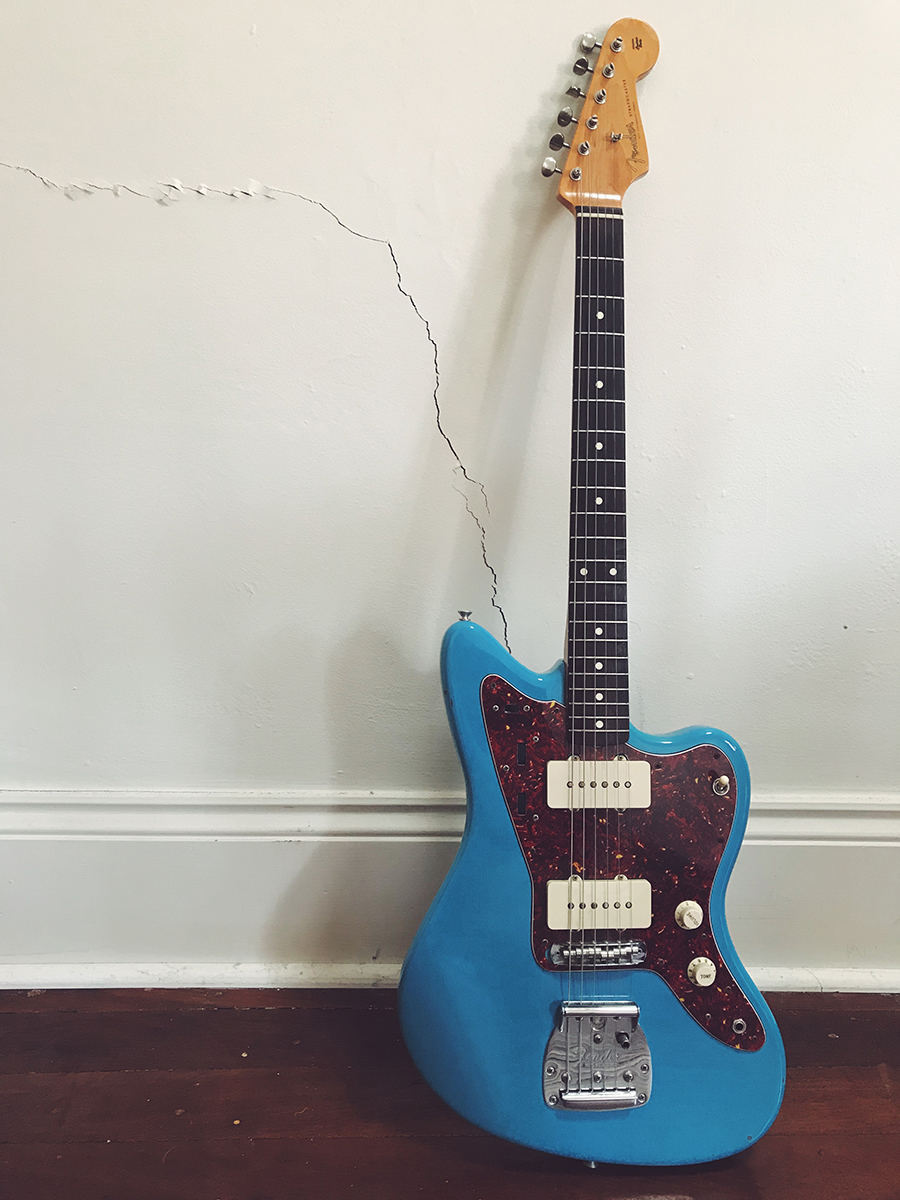
HAPPY: What do you have on your board at the moment that’s integral to your sound?
ALISTER: The Zoom MS70, definitely. Despite my early distaste with Zoom multi-fx pedals, I really love this pedal. It does all my washy reverb (think Yamaha FX500 soft focus patch) and deserves to be on any and every shoegaze/dream-pop board. I bought the Timmy overdrive after watching a studio diary of Fleeting Joys and it’s pretty much an always-on pedal for me now. While the GEC9 doesn’t have ‘a sound’, I’d be lost without its signal routing abilities.
HAPPY: Tell us about your signal chain/routing then.
ALISTER: The GE9 is the brain of my board – everything runs into and out of that. I’ve set it up so that I can run two separate effects chains into two amps and can change the effects on both amps at once with one footswitch, which saves me from ridiculous pedal tap dancing. The LS2 is on the board in case I don’t have the luxury of two amps for whatever reason, as it allows me to blend the two chains into one. In terms of effects chain, I follow the traditional tuner, fuzz, distortion, modulation, delay, reverb pattern when I’m playing live. On the record there’s some distortion-after-reverb fun, but I leave that up to Zach when we play live. Reading a written explanation of the signal chain would be tiresome I think, so here’s sketch for anyone interested in that:
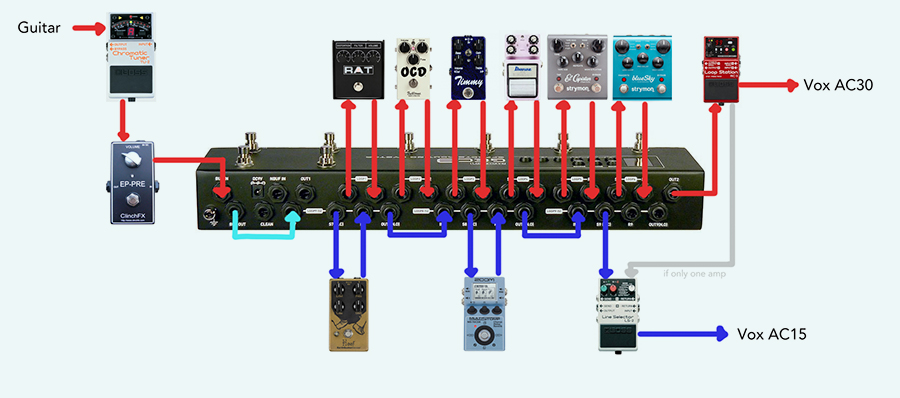
HAPPY: Do you switch pedals in and out often?
ALISTER: I’m not a big pedal flipper and I only have one or two pedals that don’t have a place on my board right now. I know guitarists who seem to have a new pedalboard every week, but I’m more interested in finding what works and sticking with it.
HAPPY: Is there anything you’re really hanging out to buy at the moment?
ALISTER: There’s some pedals that I can’t justify purchasing right now that I would love to get my hands on like the Empress Reverb, the Hologram Electronics Infinite Jets, and the Cooper FX Generation Loss. Once I’ve recovered from the album production and tour I can perhaps think about scratching that itch.
HAPPY: Who are some of your favourite pedal builders?
ALISTER: Earthquaker Devices make consistently amazing pedals. Great sounding, interesting designs, solid build quality. I only have the Hoof at the moment, but I’ve never played an EQD pedal that I didn’t like. The other company that comes to mind is Chase Bliss. I’ve never owned one of their pedals but I find their design philosophy super interesting and I love watching Joel demo his pedals. His enthusiasm for his craft is infectious.

HAPPY: Do you have any particular ethos when it comes to using guitar pedals?
ALISTER: I’m not a fan of stacking gain pedals – it’s just never worked for me – so I try get the sound I want out of one pedal at a time. This is why I have four different gain pedals on my board and why the GEC9 switcher is so important. They each achieve a different sound alone and the switcher lets me change between them immediately without stacking.
HAPPY: If you had to cull your board down to two pedals, what would they be and why?
ALISTER: Zoom MS70 and the Timmy. That would be the bare minimum that would still let me be able to get the dreamy reverb wash and distortion contrast that I love.
HAPPY: Do your pedals influence what amp or guitars you use, or vice versa?
ALISTER: My guitar and amp choice influences what I look for in pedals. The AC30 and Jazzmaster are staples for me so it’s always been about finding pedals that sound good through the Vox and that cooperate with the subtle pitch fluctuations when I’m using the Jazzmaster tremolo.
HAPPY: Do you have any pedal heroes or other artists who you feel really nail a sound through their rig?
ALISTER: The boring answer would be Kevin Shields/Neil Halstead, so instead I’ll say that Brodie Brümmer (Flyying Colours) and Gabe Lewis (Lowtide) are two guitarists who I think have their sound perfected. Brodie captures the contrast of jangly chorus and crushing wall of sound so perfectly live and it blows my mind that his main ‘fuzz’ is actually an octave synth pedal. It just sounds so good. Meanwhile, Gabe’s multi-chain pedalboard is incredible, as is the lush cascading wash of sound he achieves with it. The way he uses a Tiesco Spectrum 5 split between three effects chains and amps appeals to me greatly.
Catch Blush Response live:
April 7 – Botany View Hotel, Sydney
April 14 – The Yarra Hotel, Melbourne
April 20 – The Crown & Anchor, Adelaide
May 5 – Bloodhound Bar, Brisbane
More details over at Blush Response’s Facebook. Cruel is the second single taken off Blush Response’s upcoming debut album Hearts Grow Dull, set for release in April.
